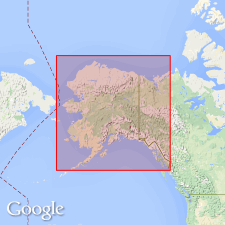
- Usage in publication:
-
- Koyukuk series*
- Modifications:
-
- Named
- Biostratigraphic dating
- Dominant lithology:
-
- Limestone
- Shale
- AAPG geologic province:
-
- Alaska West-Central region
Summary:
Constitutes southern 45 mi of section lying principally between 66th parallel and Arctic circle on Koyukuk River. May have wide extent over Koyukuk basin, AK. Consists of impure pink and reddish limestone, slate, dark shale, some sandstone and arkose, all more or less associated with or intruded by igneous rocks. No estimate of thickness can be given due to various breaks and changed attitude of rocks, but limestone is about 800 ft thick. Underlies Bergman series (new). Correlated with Anaktoovuk series (new) on basis of presence of AUCELLA CRASSICOLLIS Keyserling fossil; thus age is considered to be Early Cretaceous.
Source: GNU records (USGS DDS-6; Menlo GNULEX).

- Usage in publication:
-
- Koyukuk group*
- Modifications:
-
- Redescribed
- AAPG geologic province:
-
- Alaska West-Central region
Summary:
Koyukuk series of Schrader (1902) renamed Koyukuk group. Described as limestones, sandstones, and shales with associated pyroclastic and extrusive rocks. Age is Early Cretaceous based on fossils in limestone and stratigraphic relations in region.
Source: GNU records (USGS DDS-6; Menlo GNULEX).
For more information, please contact Nancy Stamm, Geologic Names Committee Secretary.
Asterisk (*) indicates published by U.S. Geological Survey authors.
"No current usage" (†) implies that a name has been abandoned or has fallen into disuse. Former usage and, if known, replacement name given in parentheses ( ).
Slash (/) indicates name conflicts with nomenclatural guidelines (CSN, 1933; ACSN, 1961, 1970; NACSN, 1983, 2005, 2021). May be explained within brackets ([ ]).

